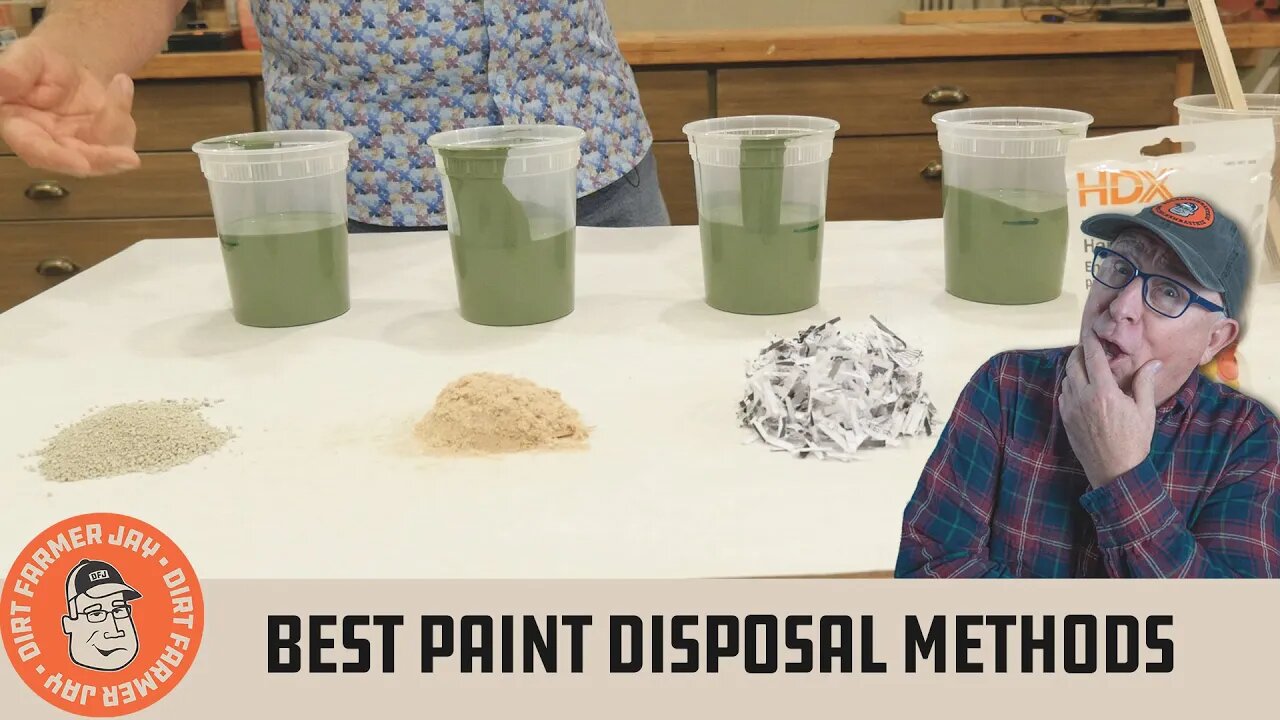Premium Only Content

Best Latex Paint Disposal Methods
It’s time to dispose of leftover paint you have - what is the right way to safely throw that leftover paint away? We’ll show you the best ways to do that - without harming the environment!
#paint #painthardener #wastepaint #paintdisposal
Buy your DFJ T-Shirt, Cap, or Coffee Mug at https://www.dirtfarmerjay.com/shop
It’s easy to get a stockpile of leftover paint. The day comes when you need ti get rid of it, but you want to do it correctly. Good for you, but what are some paths forward?
Water-based paint, usually known as latex or acrylic, is relatively easy to dispose of. The paint needs to be dried before putting it in the trash. We’ll show you some ways to do that.
Oil-based paint is another story. These paint and finishes are hazardous materials that must be disposed of at a designated waste collection site. Many cities host annual waste collection days when oil-based paints (and water-based paint too!) can be disposed of. Many landfills, especially those that serve many communities, will have a designated drop-off area for oil-based paint as well as other hazardous materials such as batteries, solvents, pesticides, and herbicides.
Now, on to “latex”, “acrylic” or “water-based” paint. This type of paint has become the most popular for its ease of application, low emission of VOCs (volatile organic compounds), and ease of cleanup of tools, brushes, and rollers.
But, just because the paint can be cleaned up with soap and water (at least when it is wet!), doesn’t mean that it is harmless to the environment. That paint is made up of pigment (for color and opaqueness), binder (also known as a coagulant), resin (emulsifies the pigment and keeps it in suspension), and water (as the solvent for all the ingredients).
If the paint is liquid when placed into the waste stream, there’s a possibility of leaching into groundwater or causing a mass of trash that will be very resistant to degradation. So, the paint needs to be dried before disposal.
Whatever method you use, leave the lids off the paint when you put them in the trash container. If there is a visual inspection by the trash pickup personnel, they can see that the contents have been treated and dried.
There are several ways to dry paint, including:
Pour out a thin layer onto sheets of newspaper until dry then discard. This is inexpensive and uses material that was going to be discarded anyway. However, if you have a lot of paint, it takes lots of room and time.
Shred newspaper and mix it into leftover paint until the liquid is absorbed. Leave the lid off until dry and throw away. This is cheap, and pretty fast, but it is best for smaller amounts. If you have a paper shredder, you can use the shreds this way too.
Kitty Litter or oil absorbent can be used to sop up the moisture in paint to be discarded. It’s readily available and pretty inexpensive. The trade-off is that it takes a lot of kitty litter or absorbent to absorb all the moisture, so if you have an almost full can of paint, you could end up with 2 to 3 cans of kitty litter/paint mixture. It’s heavy too!
Sawdust or small woodchips can be used. If you have a good source, it’s cheap. Just be aware it takes a lot of it to properly wick up all the moisture, and with that comes bulk. This is best used for cans that are ⅓ or less full.
Air Dry. You can pry off the lid and let it sit for a week or two. This only works with minute amounts as the paint will “skin” and form a dry crust, but will significantly impede the drying of the whole batch. You’ll need to stir up wet paint to the top to get all of it dried.
Paint Hardener can be purchased from your favorite paint supplier. This is sold in packets that will harden up to ⅔ of a gallon at a time. These usually contain sodium polyacrylate (Geek note: Sodium Polyacrylate is a sodium salt of Polyacrylic Acid) and the salt crystals absorb moisture very quickly and turn the paint into a thick, rubbery mass. At the time of filming, the paint hardener was about $2.50 per packet. The material is listed as safe when properly handled. It acts quickly, and it is very convenient.
Coconut (or “coco”) pith, sold as a paint cleanup and drier product by Eco Industrial Solutions, is packaged under the name Spill Bully®. At the time of filming, a ½ pound (.22kg) container of the product cost right at $13 U.S., with the package stating, “Cleans 2 Quarts.” Coco pith is also known as coco peat and is made from the husks of coconuts. In contrast, coco coir is made from the fibers of coconuts. Coco pith is much more absorbent than coco coir - hence it’s used for spill clean-ups and paint hardening.
Whatever method you use, thanks for making the effort to properly dry and dispose of your waste paint! You rock!
JUST DO IT YOURSELF!
Instagram: https://www.instagram.com/dirtfarmerj
Facebook: https://www.facebook.com/dirtfarmerjay
-
 LIVE
LIVE
Rotella Games
16 hours agoGreen Hell Day 6 | We Have a LONG Way to Go
55 watching -
 LIVE
LIVE
Lofi Girl
2 years agoSynthwave Radio 🌌 - beats to chill/game to
545 watching -
 41:26
41:26
The Mel K Show
3 hours agoMel K & Clay Clark | Financial Success Hides Behind Self Discipline: Five Pillars | 8-24-25
15.3K1 -
 LIVE
LIVE
The Rabble Wrangler
11 hours agoThe Best in the West Plays Battlefield 2042 | Road to BF6 Grind
22 watching -
 LIVE
LIVE
JTtheSG
23 minutes agoBack To The Deadzone!!!
7 watching -
 LIVE
LIVE
The Official Steve Harvey
12 days ago $5.07 earned24 HOURS OF MOTIVATION w/ STEVE HARVEY
468 watching -
 25:56
25:56
DeVory Darkins
20 hours ago $0.66 earnedTrump drops ULTIMATE BOMB on Democrat Mayors as ICE makes SHOCKING Announcement
40.6K162 -
 3:36:30
3:36:30
TonYGaMinG
5 hours ago🟢 ABI WITH FRIENDS | 🍩JOE DONUTS | 😶 🌫 VLADSGAMINGCARTEL |
21.3K4 -
 21:24
21:24
marcushouse
12 hours ago $0.10 earnedStarship Flight 10: Go or No? 🚀
21.8K12 -
 LIVE
LIVE
MrR4ger
17 hours agoSUNDAY FUNDAY w/ R4GER - VARIETY / DIABLO 4/ FOR HONOR / ETC?
95 watching